Choose LED Light for Window Displays and Signage
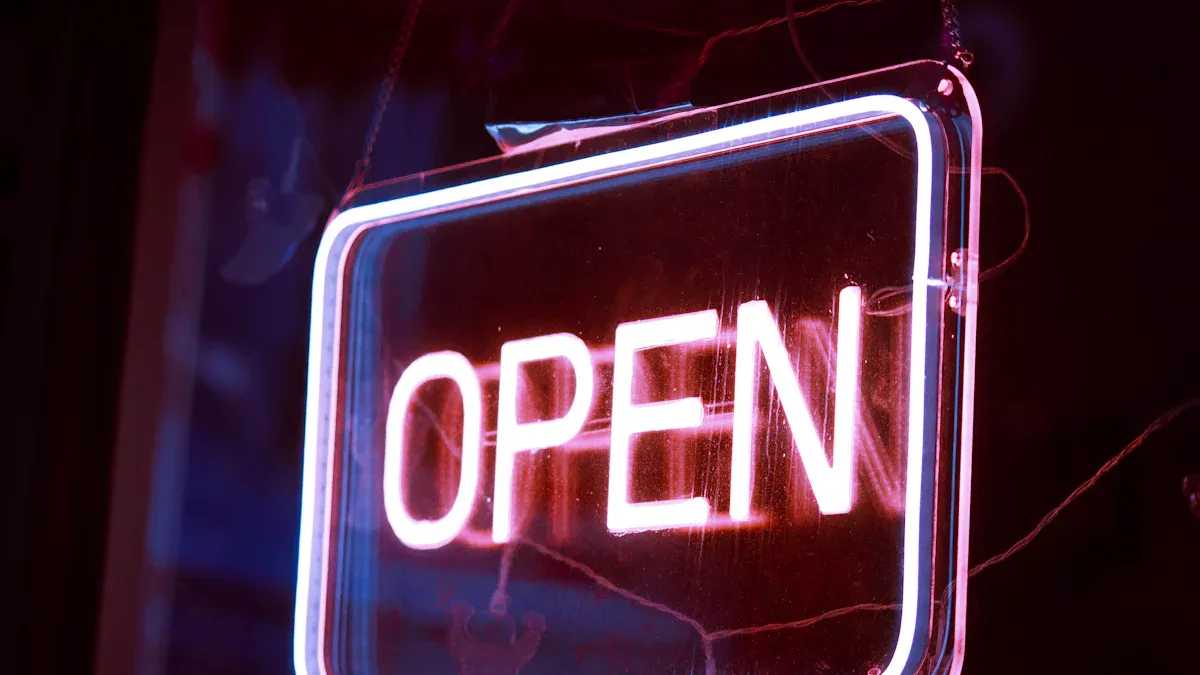
When you choose LED light for window displays and signage, your business gains a significant advantage. Good lighting helps people see your signs from far away, making your signs stand out and grab attention. Studies show that businesses that choose LED light attract more foot traffic. Bright and colorful LED lights pull people in and help you showcase your products effectively. They also help set the perfect mood for your display. By choosing LED light for your signs, you save energy and make a strong impression. With many LED lighting options available, you can easily match your signs to any business goal.
Key Takeaways
Choose LED lights with the right brightness and color to make your signs clear and eye-catching in any setting.
LED lights save energy and money because they use less power and last much longer than old lighting types.
For outdoor signs, pick LED lights with strong weather protection like IP65 or higher to keep them working in rain and dust.
Use LED lights that fit your space and style, and update colors or messages easily to keep your display fresh and attractive.
Keep your LED signs clean and check them often to make sure they stay bright and last a long time.
Choose LED Light: Key Factors
When you pick signage lighting led for your business, you should think about a few important things. These things help your signs look good inside and outside. Let’s talk about what you need to check so your signs get noticed and last a long time.
Brightness & Color
Brightness is very important when picking signage lighting led. You want people to see your signs all the time. For window displays behind glass, you need ultra-high brightness, about 3000 nits. This helps your signs show up even in sunlight or with reflections. Indoor screens should have at least 300 nits, but 400 nits is better if the room is bright. Outdoor screens often need a 2:1 brightness-to-illuminance ratio, with 3000 nits working for most cases. At night, outdoor screens should be dimmed to 100–150 nits so they are not too bright.
Low brightness (≤ 800 nits): Good for indoor places with little light, but not for window displays.
Medium brightness (800–1200 nits): Works for indoor and some outdoor signs with medium light.
High brightness (1200–2500 nits): Best for outdoor or bright indoor areas, like window displays.
Ultra-high brightness (3500 nits and above): Needed for direct sunlight or very bright spots.
Color temperature changes how your signs look. Warm light (2000K–3000K) makes things feel cozy and helps warm colors stand out. Neutral light (3100K–4500K) shows true colors, which is good for stores. Cool light (4600K–6500K) makes blues and greens pop and feels lively. You can change color temperature and brightness to fit your products and the feeling you want. For example, use warm colors for clothing shops and cool colors for electronics.
Tip: Change both brightness and color temperature to fit your display’s job and the light around it. This helps your signs get more attention and look great.
Energy Efficiency
Energy-efficient lighting saves money and helps the planet. LED signage uses much less power than old lights. For example, LED neon signs use only 657 kW each year, but glass neon uses 1752 kW and fluorescent lights use 2672 kW. LEDs turn about 90% of power into light, but glass neon only does 20%. This means you pay less for power with led signage.
Lighting Type | Power Draw (Watts) | Energy Consumption (kW per Year) | Efficiency (%) | Annual Cost (CA, $) | Annual Cost (CO, $) |
|---|---|---|---|---|---|
LED Neon | 150 | 657 | 90 | 130 | 80 |
Glass Neon | 400 | 1752 | 20 | 348 | 213 |
Fluorescent | 610 | 2672 | 10 | 531 | 325 |
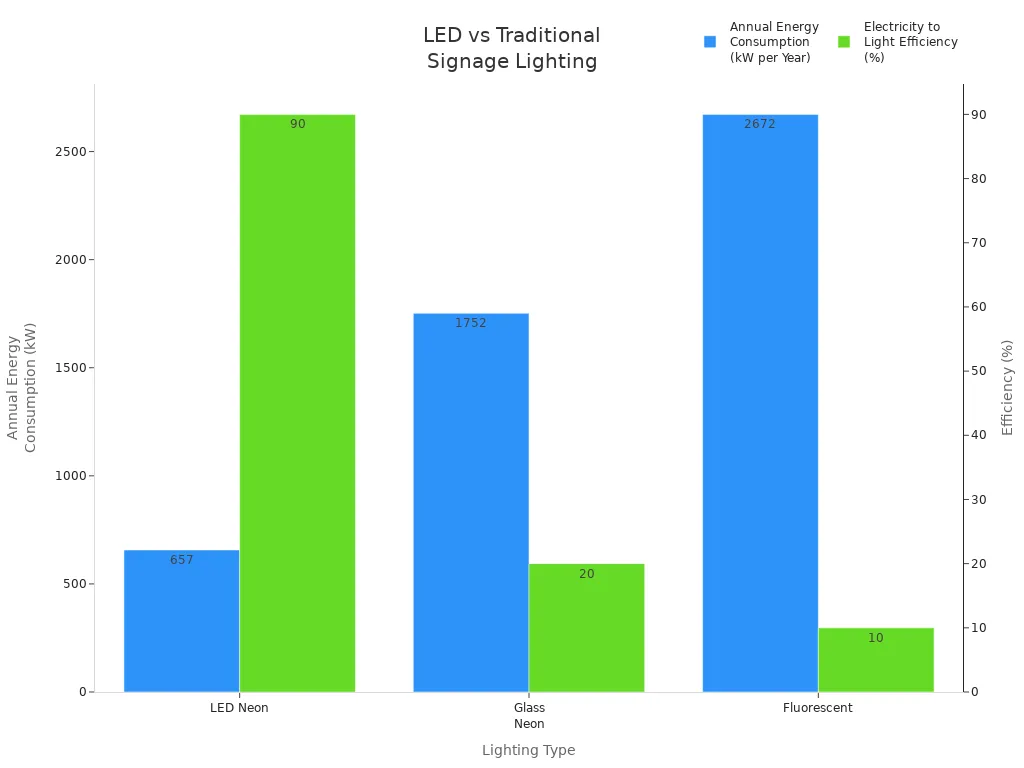
Switching to led signage can save your business a lot of money every year. For example, if you change 100 old bulbs to LEDs, you could save about $15,600 each year on power bills. LEDs also last longer, so you do not need to replace or fix them as often.
Weather Resistance
If you use signage lighting led outside, you need to make sure it can handle rain, dust, and hot or cold weather. Look for IP ratings to see how well your lights keep out water and dust. IP65 and IP67 are the most common for outdoor led signage. IP65 means your lights keep out dust and can take water jets from any side. IP67 means your lights can go underwater for a short time.
IP Rating | Protection Level | Typical Outdoor Use Case |
|---|---|---|
IP44 | Splash-proof | Basic outdoor areas |
IP65 | Dust-tight, water jets | Rain, irrigation |
IP66 | Dust-tight, strong water jets | Heavy rain |
IP67 | Dust-tight, temporary immersion | Flood-prone areas |
IP68 | Dust-tight, continuous submersion | Underwater |
Outdoor led lights also need to work in very hot or cold weather. Good outdoor signage lighting led uses strong materials like tempered glass and metals that do not rust. Good heat sinks and vents help with temperature changes. Make sure your power supplies and drivers are made for the weather in your area.
Note: Always pick signage lighting led with at least an IP65 rating for outdoor use. This keeps your signs working in all kinds of weather.
Size & Installation
The size and setup of your signage lighting led change how your display looks and works. Most business window displays use screens between 55 and 100 inches. Transparent LED films can cover big windows, usually between 65 and 100 inches. For indoor screens, a pixel pitch of 1–3 mm gives you clear pictures even up close.
Parameter | Details |
|---|---|
Standard Sizes | 55–100 inches for window displays; 65–100 inches for transparent LED films |
Pixel Pitch | 1–3 mm for indoor screens, best for 2–5 meter viewing distance |
Brightness | Indoor: 500–1,500 nits; Outdoor: 5,000–10,000 nits |
Durability Rating | Indoor: IP20; Outdoor: IP65+ |
Modular Design | Panels from 10–50 inches, allowing custom shapes |
Aspect Ratios | 16:9 for widescreen; 4:3 for square or vertical displays |
Installation Considerations | Viewing distance, pixel pitch, brightness, durability, mounting system |
When you put in signage lighting led, always match the bulb base to your fixture. This stops loose connections and keeps your lights safe. Also, pick the right lumens for your space. For example, living rooms need 10–20 lumens per square foot, but kitchens need 70–80 lumens per square foot. Using the right base and lumens gives you the best light and makes setup easier.
Remember: The right size, base, and lumens help your signage lighting led look good and work safely, inside and outside.
By thinking about these things when picking signage lighting led, you make sure your led signage stands out, saves energy, and lasts a long time. Always check for ENERGY STAR® certification to make sure your lighting is high quality and efficient.
Types of Signage Lighting LED
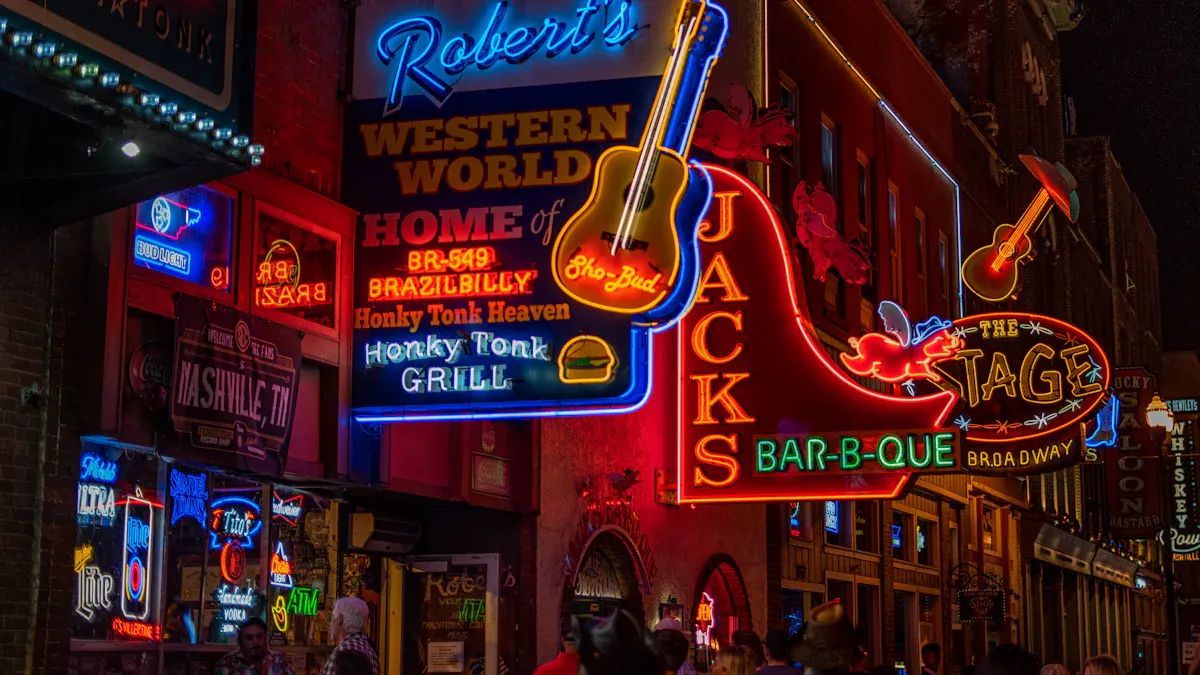
LED Strip Lights
You can use LED strip lights for many signage applications. These strips work well for retail displays, shelf lighting, and window displays. You can bend and cut them to fit almost any shape or size. This flexibility helps you create unique designs for your signage. LED strip lights give you bright, even lighting behind logos or banners. You can choose high-CRI white or RGBW strips for true and vivid colors. Outdoor-rated strips with IP65 or higher ratings work well for outdoor signage. You can install them behind acrylic signs or inside lightboxes. Many strips come with adhesive backing, making installation easy. You can also use aluminum channels and diffusers for even light and extra protection.
Retail displays and menu boards
Backlit branding and channel letters
Outdoor signage with weatherproof strips
Tip: Use controllers to create dynamic lighting effects and save energy with LED strip lights.
LED Modules
LED modules give you more flexibility for complex signage shapes. You can find them in many sizes and power levels. Some modules bend and shape to fit curved or detailed designs. High-power modules use SMD or through-hole LEDs for bright, even lighting. You can connect modules in series and cut them to fit your display. LED modules work well for both indoor and outdoor signage. They last a long time and keep their brightness over years of use. You can use them for channel letters, box signs, and custom logos. Many modules have water-resistant designs for outdoor use.
LED Neon Signs
LED neon signs look like classic neon but use modern LED technology. You get higher brightness and better visibility in all lighting and weather. LED neon signs use less energy and last longer than glass neon. They resist breakage and need less maintenance. You can program colors and effects to update your display easily. LED neon signs work well for window displays and outdoor signage. They are safer because they do not use glass or gas. You can choose from many shapes and colors to match your brand.
Backlit & Direct-View Displays
Backlit and direct-view LED displays help your signage stand out. Backlit signs use LEDs behind graphics or text to create a steady, bright glow. This makes your message easy to read day or night, even in fog or rain. Direct-view displays use small LED bulbs to show bright, colorful images and videos. These displays work indoors and outdoors, thanks to high IP ratings that protect against water and dust. You can build large video walls or simple signs. LED technology gives you energy efficiency, long life, and strong visibility. Backlit signs add depth and animation, making your signage more eye-catching.
Note: Choose the right types of signage lighting LEDs to match your display needs, location, and quality standards.
Benefits of LED Signage
Visual Impact
Using led signage helps your business get seen. LED lights are much brighter than other lights. This makes your signs easy to spot from far away. The colors look real and clear, almost like natural sunlight. Most LEDs have a color rendering index between 70 and 95. This means your products look great under the lights. Your display stands out and looks more attractive to people. LEDs do not make ultraviolet rays like fluorescent lights do. So, your signs stay bright and do not lose color over time.
Feature | LED | Fluorescent | Incandescent |
|---|---|---|---|
Brightness (Efficiency) | High system efficiency (>50 lm/W), source efficiency 37-120 lm/W | Moderate source efficiency (50-100 lm/W), lower system efficiency (<30 lm/W) | Very low efficiency (<10 lm/W) |
Color Rendering Index (CRI) | Broad range 65-95, generally superior | Typically 62-80, decent but lower than LED | 100, excellent color accuracy |
Light Directionality | Directional (180 degrees), focused on target area | Omnidirectional (360 degrees), requires reflectors | Omnidirectional |
Ultraviolet Emission | None | Some UV emission, potential hazard | None |
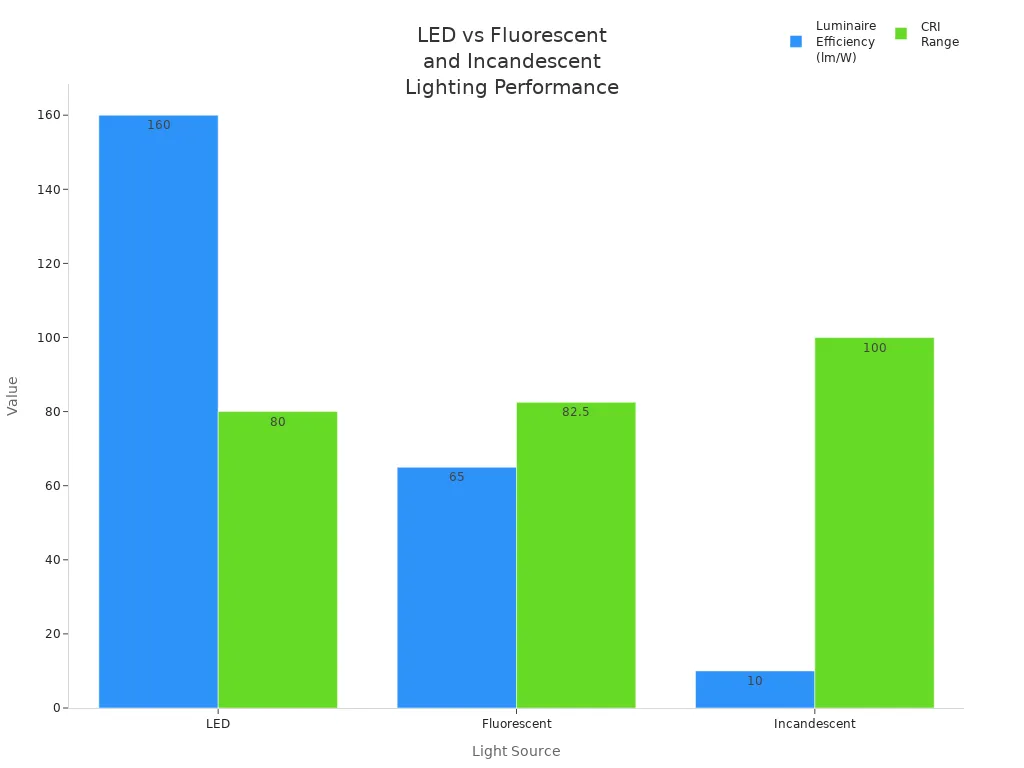
Durability & Lifespan
LED signage lasts much longer than other lights. Most LED lights work for 25,000 to 50,000 hours. Some can even last up to 100,000 hours if used right. You do not need to change bulbs very often. This saves you both time and money. LED signage is made to handle tough weather and dust. It can even work in direct sunlight. Many signs are weatherproof and use strong materials. They keep working in rain, wind, or heat. You can count on your signs to shine bright in busy places or outside.
Lighting Technology | Average Lifespan (hours) |
|---|---|
25,000 - 50,000 (up to 100,000 in ideal conditions) | |
Incandescent Bulbs | 1,000 - 2,000 |
Halogen Bulbs | 1,250 - 4,000 |
Compact Fluorescent Lamps (CFLs) | 8,000 - 15,000 |
Tip: Clean your LED signs often and replace broken modules quickly. This helps your signs stay bright and last longer.
Customization
You can make led signage fit any space or brand style. LED displays come in many shapes, sizes, and colors. You can program them to show moving words or pictures. Some can even show live updates. This lets you change your message anytime you want. You do not have to pay extra to update your sign. You can also change the brightness and color to match your brand or the time of day. Some systems let you control your sign from a computer or phone. This makes updates fast and simple. These features help your business look new and reach more people.
Show moving pictures and words to get attention.
Change messages for sales or holidays in just seconds.
Use different languages to talk to more customers.
Signage lighting leds help you save energy and last a long time. You can make displays that really stand out. With great lighting and easy changes, your business gets noticed and your signs always look good.
Digital Signage: Practical Tips
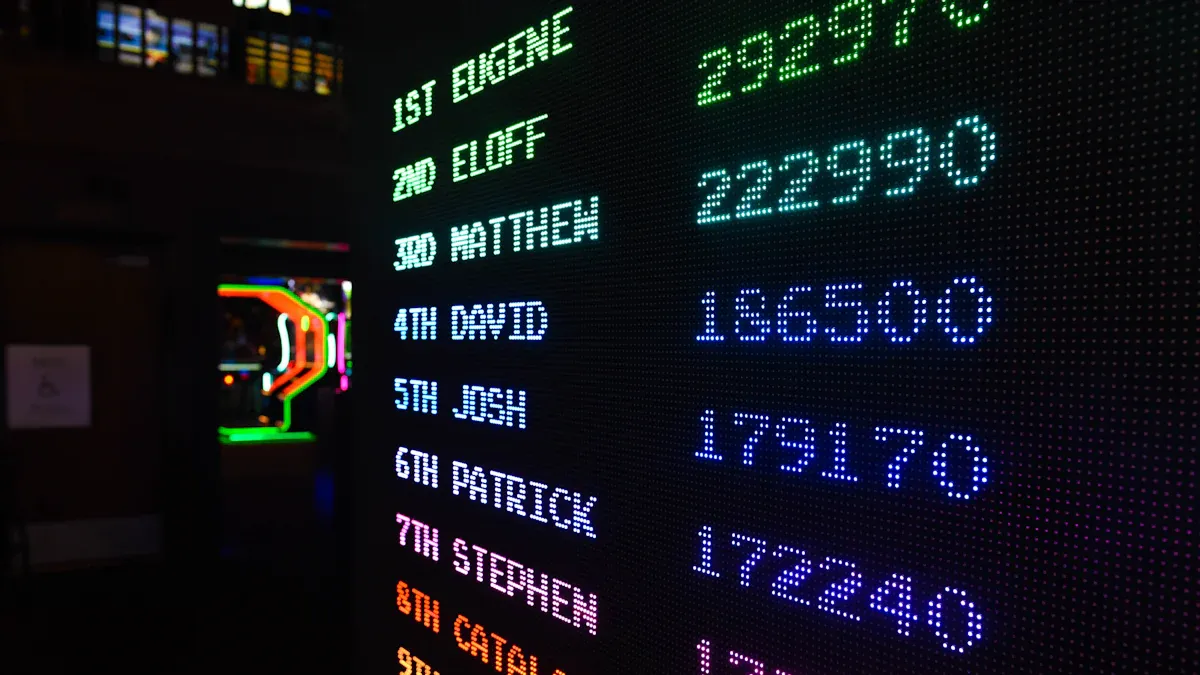
Selection Guide
Think about where you will put your digital signage. Outdoor signs need to stand up to rain, wind, and sun. Pick displays that are bright so people can see them on sunny days. Indoor digital signage, like menu boards, should have lower brightness and high resolution. This makes pictures and words look clear up close. Always check if the signage brand is trusted and has good support. Ask for customer reviews and see if the supplier helps with design and setup. Pick signage that fits your brand’s colors, shapes, and lighting. Choose digital signage that is easy to take care of and saves energy. This helps you spend less money over time.
Tip: Using one supplier for all your digital signage makes setup and support easier.
Installation Tips
You want your digital signage to be safe and look nice. Use the right tools and measure before you hang the display. Make sure the wall or surface is strong enough. For outdoor signs, use led displays with at least an IP65 rating. This keeps out water and dust. Use sealed boxes and mounts that do not rust. Plan where your cables will go and label them for easy fixes later. Always follow safety rules and wear the right gear. This is important for big menu boards or signs that are high up. Test the network and power before turning on the display.
Use cable trays and fire-safe pipes for neat and safe wires.
Make sure your digital signage software works with your hardware.
Maintenance
Keep your digital signage bright and working by caring for it often. Wipe the screens with a soft cloth to get rid of dust. Check fans and vents so the display does not get too hot. For outdoor signs, look at seals and boxes for leaks after storms. Update your digital signage software to fix problems and get new features. If you see flickering or blank spots, check the power and cables first. Replace broken led modules quickly. For big issues, call a pro for help. Change your content often so people stay interested and your menu boards look new.
Note: Checking and cleaning your digital signage often helps it last longer and saves money on repairs.
If you pick led light for your window displays and signage, more people will see them. You also use less energy and make your business stand out. Look at how bright the lights are and what colors they show. Make sure they are easy to put in your space. New LEDs have cool features and can fit many designs. You can see if they work well by counting how many people come in and watch what customers do. Pick led light that matches what you want for your business. Ask a lighting expert for help with new ideas and trends.
FAQ
What is the best brightness for window display LED signs?
You should choose at least 3000 nits for window displays. This level helps your sign stay visible in sunlight. For indoor displays, 400 nits works well. Always match the brightness to your location.
How do I know if my LED sign is weatherproof?
Look for the IP rating on your LED sign. IP65 or higher means your sign can handle rain and dust. You can find this rating on the product label or in the manual.
Can I change the color of my LED signage?
Yes, you can. Many LED signs let you pick different colors and effects. Use a remote or an app to control the color. This helps you match your sign to your brand or event.
How long do LED signs usually last?
Most LED signs last between 25,000 and 50,000 hours. Some can work up to 100,000 hours. You will not need to replace them often. Clean your sign to help it last longer.
Do LED signs use a lot of electricity?
No, LED signs use much less electricity than old lights. You can save money on your power bill. LED signs also help the environment by using less energy.
Tip: Always check the energy label before you buy an LED sign. This helps you pick the most efficient option.
See Also
Selecting The Best LED Display Sign For Your Company
Finding The Ideal LED Digital Sign For Business Use
Tips For Picking The Best Acrylic LED Display Board

